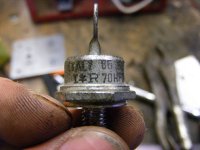OP
joshuabardwell
Elite Member
I don't have the diagnostic tools or knowledge to design the choke/capacitor circuit that would be needed for this. I should be more specific - is such a DC converter available as a completed external 'black box'?
Ahh. Well, I have never heard of such a thing. A little Googling turned this up, though:
http://www.tractorbynet.com/forums/build-yourself/132469-turning-ac-stick-welder-into.html
All roads lead back to TBN!
EDIT: And here's the thing you're looking for. http://www.proto-power.com/dc_cheater.html
